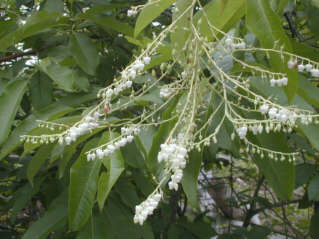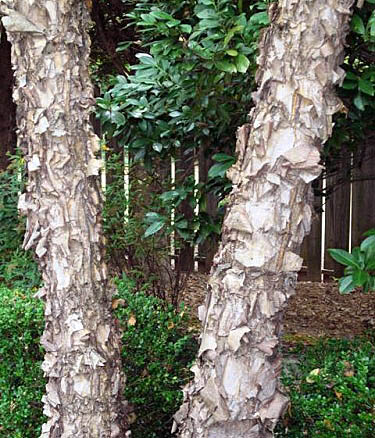Our Multipurpose Native Trees

Yellow Poplar
More people are choosing to plant native trees, as they learn of their benefits and importance. Native trees are defined as those that were growing on our continent before the European settlers arrived. These trees have developed a taste for our soils, a tolerance of our rainfall and temperatures, and a resistance to our serious pests and diseases. For these reasons, native trees are mostly carefree. After all, they have survived thousands of years in the wild without much help from us.
However, the term, native, can also refer to a particular region. For example, redwood trees are native to the continent, as they were growing here before the European settlers arrived, but they are not native to Virginia.
Non-natives, also called alien or exotic species, are native to another land. They either hitched a ride on cargo shipments or were brought and planted here by humans. Without the adaptations to our growing conditions, their survival requires more attention and maintenance than natives, including watering, soil improvement and spraying treatments.

Sweetbay Magnolia
In many instances, non-natives serve no useful purpose other than appearance. Native trees, on the other hand, are important to the ecology and environment. Some native trees grow in rock outcroppings, clay soils or swampy lands where few other trees will. Along creeks and rivers, their roots are important for erosion prevention and stream-bank stabilization.
Native trees are most important to our native wildlife. They provide suitable places for nesting, shelter and food. For example, our native dogwood tree (Cornus florida), supplies food and habitat for 117 species of moths and butterflies alone, while the imported Korean Dogwood (Cornus kousa) supports no insects in our country, and therefore supports no insect-eating birds. Many birds species time their migrations to the production of food (seeds and berries) from native trees and shrubs.

Sourwood
There are native trees for any use in the landscape, from understory trees and shrubs that survive on limited sunlight below larger trees, to fragrant flowering trees, to large trees that give cooling shade in the summer. In addition, natives support all the other living critters we cherish in our gardens.

River Birch
- Native trees for wet areas
- River Birch (Betula nigra)
Reddish brown to cinnamon-red, peeling back in tough papery layers to reveal multiple colors, giving the trunk a ragged and distinctive appearance. River birch is commonly planted for stream bank restoration and other erosion control situations. It is also an attractive ornamental tree. - Pin Oak (Quercu palustris)
The acorns are eaten by waterfowl, turkeys, jays, woodpeckers and squirrels. Pin oak is a popular landscape tree because of its fast growth, ease of transplanting, tolerance of urban stresses and good fall color. - Sweetbay Magonlia (Magnolia virginiana)
Produces fragrant creamy white flowers. The foliage and twigs are a favorite browse for deer, and the seeds are eaten by birds and small mammals. Sweetbay is also grown as an attractive landscape tree.
- Native blooming trees
- Sourwood (Oxydendrum arboreum)
White, flowers 1⁄4 inch long, urn-shaped, hanging below long stems droop, then lift upward, resembling lily-of-the-valley flowers, appearing in mid-summer. Bees use the flowers’ nectar to make a unique and desirable honey. It is sometimes planted as an ornamental for its attractive summer flowers and fall foliage. - Serviceberry (Amelanchier arborea)
Showy flowers, each with 5 half-inch white petals, in elongated drooping bunches, appear in spring just before or with the leaves. Many birds and mammals eat the berries. Serviceberry makes a beautiful ornamental tree for the home landscape. - Yellow Poplar (Liriodendron Tulipifera)
Flowers with tulip-shaped, yellowish-green blooms, 2 to 3 inches across, marked with orange bands near the base. The flowers are an important nectar source for honey production. Yellow- poplar makes an impressive shade tree for large landscapes.
- Understory native trees preferring light shade
- Eastern Redbud (Cercis canadensis)
Flower buds are round and often in large clusters on older woody stems in spring. Some birds and mammals eat the seeds. Redbud is planted as an ornamental tree suitable for small landscapes. - Flowering Dogwood (Cornus florida)
Small tree shows large, white (occasionally pink), notched, petal-like bracts. 35 species of birds and many large and small mammals are known to eat the seeds, although poisonous to humans. Deer and rabbits browse the foliage and twigs. Dogwood is planted as an attractive ornamental tree.
- Evergreen native trees
- Eastern Red Cedar
Wood is fragrant and its natural oils repel insects. Berries a favorite food of many birds, from waxwings to bobwhite quail. Red cedar’s dense foliage provides excellent roosting and nesting cover for birds. Red cedar is good for protecting soils from erosion. - American Holly (Ilex opaca)
The bitter-tasting berries are food for songbirds, deer, wild turkeys and a wide variety of other animals. - Eastern White Pine (Pinus strobus)
Deer and squirrels browse the foliage and bark. Seeds are a food source for red and gray squirrels and for songbirds. White pines are often planted to stabilize the soil on mined lands.
- Native shade trees
- Red Maple (Acer rubrum)
The fruit and buds are a primary food source for gray squirrels in late winter and early spring. Birds and mice eat the seeds. Red maple is a popular shade and ornamental tree, with brilliant fall color. It tolerates the widest variety of soil conditions of any North American forest species. - Pawpaw (Asimina triloba)
Pawpaw fruits are eaten by raccoons, opossums, squirrels and birds. Pawpaw leaves are the only food source for caterpillars of the zebra swallowtail butterfly. - White Oak (Quercus alba)
Acorns are sweet and a preferred food of deer, bear, turkeys, squirrels and other wildlife. Makes an impressive ornamental tree for large landscapes. - Scarlet Oak (Quercus coccinea)
The acorns provide food for a variety of wildlife and songbirds. The tree’s brilliant fall color, rapid growth and drought tolerance make it a popular choice for landscape planting.
Resources
Common Native Trees of Virginia, Virginia Department of Forestry
Native Plants for the Piedmont Region, Virginia Department of Conservation and Recreation